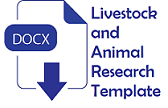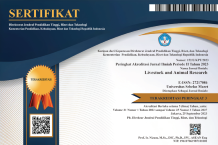Effect of using protected linseed in rations on sheep blood hematology
Abstract
Objective: Blood is a body fluid that plays a role in transporting oxygen, nutrients, metabolic waste, and serves as a component of the immune system. Its measurable indices such as hematological profile is affected by the food consumed. This study aimed to examine the linseed use in complete feed on the hematology value of sheep blood.
Methods: This research was conducted at the “Mitra Karya Farm” in Purworejo Village, Gemolong District, Sragen Regency. There were 15 male Fat-Tailed Sheep crossing 1-1.5 years old with an average body weight of 22+2.04 kg as experimental animals. The treatments applied were P1: 100% complete feed, P2: 90% complete feed and 10% linseed, P3: 90% complete feed and 10% linseed meal, P4: 90% complete feed and 10% linseed protected with tannin, and P5: 97% complete feed and 3% linseed oil that are saponified. A one-way, Completely Randomized Design (CRD) was used, and blood hematology was the measured variable, which includes the determination of erythrocytic series (red blood cells, hemoglobin, hematocrit, and erythrocyte index), leukocytes, and platelets.
Results: The results showed that the treatment applied had no significant effect on red blood cells value and erythrocyte index, but had a significant effect on hemoglobin, hematocrit, leukocytes, and platelets value. The highest sheep blood Hb (P<0.05) was P3, which did not differ from P4, P1, and P2, while P5 had the lowest Hb level. The highest blood hematocrit was in P1, and this result was not significantly different from P3 and P4, while P2 and P5 produced low hematocrit. The highest leukocytes were achieved by P4 and were not significantly different from P3. Leukocytes were the lowest at P2 and not significantly different from P1. In contrast, P4 sheep platelets were the highest and not significantly different from P3, P1, and P2, while P5 produced the lowest platelets.
Conclusions: This study concludes that the sheep that received complete feed, 90% + 10% linseed meal (P3), had the best hematology.
Keywords
Full Text:
PDFReferences
- Ayuningsih, B., I. Hernaman, D. Ramdani, and S. Siswoyo. 2018. Pengaruh imbangan protein dan energi terhadap efisiensi penggunaan ransum pada Domba Garut betina. J. Ilmu Peternakan Terpadu. 6:97. Doi: 10.23960/jipt.v6i1.p97-100
- Doreau, M., and A. Ferlay. 2015. Linseed: a valuable feedstuff for ruminants. Ocl. 22: D611. Doi: 10.1051/ocl/2015042
- Mudau, N., K. Ramavhoya, O. O. Onipe, and A. I. O. Jideani. 2021. Plant and animal based protein sources for nutritional boost of deep-fried dough. Front. Sustain. Food Syst. 5:1–9. Doi:10.3389/fsufs.2021.763437
- Benchaar, C., G. A. Romero-Pérez, P. Y. Chouinard, F. Hassanat, M. Eugene, H. V. Petit, and C. Côrtes. 2012. Supplementation of increasing amounts of linseed oil to dairy cows fed total mixed rations: Effects on digestion, ruminal fermentation characteristics, protozoal populations, and milk fatty acid composition. J. Dairy Sci. 95:4578-4590. Doi:10.3168/jds.2012-5455.
- Khotijah, L., N. Nurmiasih, and D. Diapari. 2020. Konsumsi zat makanan, profil dan metabolit darah induk domba dengan ransum kaya lemak asal minyak nabati. J. Ilmu Nutr. dan Teknol. Pakan. 18:38-42. Doi: 10.29244/jintp.18.2.38-42.
- Lyons, T., T. Boland, S. Storey, dan E. Doyle. 2017. Linseed oil supplementation of lambs’ diet in early life leads to persistent changes in rumen microbiome structure. Front. Microbiol. 8:1-12. Doi: 10.3389/fmicb. 2017.01656
- Harun, A. Y. and K. Sali. 2019. Factors Affecting Rumen Microbial Protein Synthe-sis: A Review. Vet. Med. Open J. 4:27-35. Doi: 10.17140/vmoj-4-133
- Astuti, A., R. Rochijan, and B. P. Widyobroto. 2020. Effect of dietary rumen undegraded protein (rup) level on nutrient intake and digestion of lactating dairy cows. Bul. Peternakan. 44:228-232. Doi: 10.21059/buletin peternak.v44i4.59155.
- Rochman, A. N., Surono, and Subrata. 2012. Undegraded dietary protein. Anim. Agric. J. 1:257-264.
- Shofi Ani, A., R. Iswarin Pujaningsih, and J. R. Kampus drh Soejono Kusumowardojo. 2015. Perlindungan protein menggunakan tanin dan saponin terhadap daya fermentasi rumen dan sintesis protein mikrob (protection of protein pusing tannins and saponins of rumen digestibility and microbes synthesis protein). J. Vet. 16:439-447.
- Dinata, D. D., W. Widiyanto, and R. I. Pujaningsih. 2015. Pengaruh suplementasi dan proteksi minyak biji kapuk terhadap fermentabilitas ruminal rumput gajah pada sapi secara in vitro. J. Agripet. 15:46-51. Doi: 10.17969/agripet.v15i1.2299
- Peraturan Menteri Pertanian Republik Indonesia Nomor 102/Permentan/OT.140/7/ 2014 Tentang Pedoman Pembibitan Kambing dan Domba yang Baik.
- Rahayu, S., M. Yamin, C. Sumantri, and D. Astuti. 2017. Profil hematologi dan status metabolit darah Domba Garut yang diberi pakan limbah tauge pada pagi atau sore hari (blood haematological profile and metabolite status of Garut Lamb fed diets mung bean sprout waste in the morning or evening). J. Vet. 18:38-45. Doi: 10.19087/jve teriner.2017.18.1.38
- Oramari, R. A. S., A. O. Bamerny, and H. M. H. Zebari. 2014. Factors affecting some hematology and serum biochemical para meters in three indigenous sheep breeds. Adv. Life Sci. Technol. 21:56-63. Available from: www.iiste.org
- Suharti, S. R. I., A. R. Nasution, D. N. U. R. Aliyah, and N. U. R. Hidayah. 2015. Potensi minyak kanola dan flaxseed terproteksi sabun kalsium untuk mengoptimalkan fermentasi dan mikroba rumen sapi potong secara in vitro. 1:89-92. Doi: 10.13057/psnmbi/m010114
- Nurani, F., A. Sudarman, and L. Khotijah. 2018. Hematologi anak Domba Garut pra-sapih yang diberi milk replacer terformulasi minyak ikan lemuru dan minyak canola. J. Ilmu dan Teknol. Peternak. Trop. 6:334. Doi: 10.33772/jitro. v6i3.7555
- Weiss, D. J., K. J. Wardrop. 2022. Schalm’s veterinary hematology. 7th ed. Blackwell Publishing, USA.
- Adinata, I. G. A. E. P., N. K. Suwiti, and A. Kendran. 2021. Nilai mean corpuscular volume, mean corpuscular volume, dan mean corpuscular hemoglobin darah sapi Bali yang dipelihara berbasis organik. Buletin Veteriner Udayana. 13(1):39-45. Doi: 10.2484 3/bulvet.2021.vl3.i01.p07
- Rapaport, S.I. 1987. Introduction to hema-tology. Ed ke-2. Lippincott Company, Philadelphia USA. J.B.
- Flay, K.J., F.I. Hill, and D.H. Muguiro. 2022. A review: Haemonchus contortus infection in pasture-based sheep production systems, with a focus on the pathogenesis of anaemia and changes in haematological parameters. Animals 12(10):1238. Doi: 10.3390/ani12101238
- Novoselec, J., Z.K. Salavardic, M. Didara, M. Novoselec, R. Vukovic, S. Cavar, and Z. Antunovic. 2022. The effect of maternal dietary selenium supplementation on blood antioxidant and metabolic status of ewes and their lambs. Antioxidant. 11(9): 1664. Doi: 10. 3390/antiox11091664
- Idris, S. A., Susanti, dan F. Sari. 2021. Gambaran red blood cell distribution width (RDW). Jurnal Analisis Kesehatan Kendari. 3(2):111-116.
- Zaja, I. Z., S. Vince, N. P. Milas., I. R. A. Lobpreis, B. Spoljaric, A. S. Vugrovecki, S. Milinkovic-Tur, M. Simpraga, L. Pajurin, T. Mikus, K. Vlahovic, M. Popovic, dan D. Spoljaric. 2019. A new method of assessing sheep red blood cell types from their morphology. Anim. 1130(9): 1-15. Doi:10.33 90/ani9121130
- Asadi, M., A. Toghdory, M. Hatami, and J. G. Nejad. 2022. Milk supplemented with organic iron improves performance, blood hematology, iron metabolism parameters, biochemical and immunological parameters in suckling dalagh lambs. Animals 12(4): 510. Doi: doi.org/10.3390/ani12040510
- Zhao, Y., W. Wang, and Z. Dong. 2022. Important factors affecting red blood cell distribution shouldn’t be ignored. Renal Failure 44(1):1399-1400. Doi: doi.org/10.33 90/ani12040510
- Pudjihastuti, E., J. R. Bujung, C. L. Kaunang. 2019. Profil karkas dan status hematologis darah dari sapi yang diberi UGB. Jurnal MIPA UNSRAT. 8(3):168-171. Doi: 10.35799/ jmuo.8.3.2019.26190
- Sousa, R. S., C. S. Sousa, F. L. C. Oliveira, P. R. Firmino, I. K. F. Sousa, V. V. Paula, N. M. Caruso, E. L.Ortolani, A. H. H. Minervino, and R. A. Barreto-Junior. 2022. Impact of acute blood loss on clinical, hematological, biochemical, and oxidative stress variables in sheep. Vet. Sci. 9(229):1-9. Doi: 10.3390/vet sci9050229
- Stuglin, C. and K. Prasad. 2005. Effect of flaxseed consumption on blood pressure, serum lipids, hemopoietic system and liver and kidney enzymes in healthy humans. J Cardiovasc Pharmacol Ther. 10(1):23-7. doi: 10.1177/107424840501000103.
- Reece, W. O. and M. J. Swenson. 2004. The composition and functions of blood. In: REECE, W. O. (Ed.). Dukes' physiology of domestic animals. Ithaca: Cornell University Press. p.26-52.
- Pradnyani, G.A.P., I.B.K. Ardana, N.L. Kartini. 2019. Pemberian tepung cacing tanah (Lumbricus rubellus) dalam pakan terhadap jumlah trombosit dan nilai MPV (Mean Platelet Volume) pada anak babi landrace jantan lepas sapih. Indonesia Medicus Veterinus 8(3):289-297. Doi: 10.19 087/imv.2019.8.3.289
Refbacks
- There are currently no refbacks.










